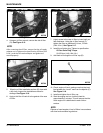
MAINTENANCE
TP-6901 6/14 Maintenance 35
4. Set drive belt tension to specification. See Figure
5-30.
• Apply specified pressure to the drive belt at its
midpoint. At the same time, measure the
amount of deflection of the drive belt at its
midpoint (D). Deflection should be within
specification.
DRIVE BELT TENSION
Applied Test Pressure
98 N (22 lb.)
Belt Deflection - New
5–7 mm (0.20–0.28 in.)
Belt Deflection - Used
7–8 mm (0.28–0.31 in.)
5. Tighten the two alternator mounting bolts.
6. Check the drive belt tension and adjust the
alternator position as needed until correct drive belt
tension is reached.
Check Wiring and Electrical
Connections
Check the condition of the wiring and electrical
connections after every 10 hours of operation. Specific
items to look for are:
• Exposed (bare) wires.
• Cuts or abrasions in wire insulation.
• Loose connections at screw terminals.
• Loose, dirty, or cracked electrical connectors.
• Melted or scorched wiring, insulation, or
connectors.
Repair or replace faulty electrical components before
operating the machine.
5.6 COOLING SYSTEM
Check Coolant Level and Condition
The engine coolant level should be checked daily
before starting the engine. Insufficient coolant will
cause the engine to overheat.
Check coolant level:
1. Open the radiator cap slowly in order to release the
pressure in the system.
2. Maintain the coolant level in the coolant overflow
bottle between the High and Low markings. See
“Coolant Recommendations” on page 24.
NOTE:
Periodically check the coolant level by removing the
radiator’s pressure cap. Do not rely solely on the level
in the coolant overflow bottle.
3. Install and tighten the radiator cap.
Check coolant condition:
Engine coolant should be uniformly colored and
transparent. Replace the coolant if it is dirty,
discolored, or fouled with oil or rust particles.
Rusty coolant may indicate corrosion inside the
radiator. Oil in the coolant indicates a leak somewhere
in the lubrication system. Contact a KOHLER
authorized distributor/dealer if either of these
conditions exist.
!
CAUTION
Electrical shock can cause injury.
Do not touch wires while engine is
running.
WARNING
!
Hot coolant and steam. Can cause severe injury
or death.
Before removing the pressure cap, stop the engine
and allow it to cool. Then loosen the pressure cap to
relieve pressure.


















